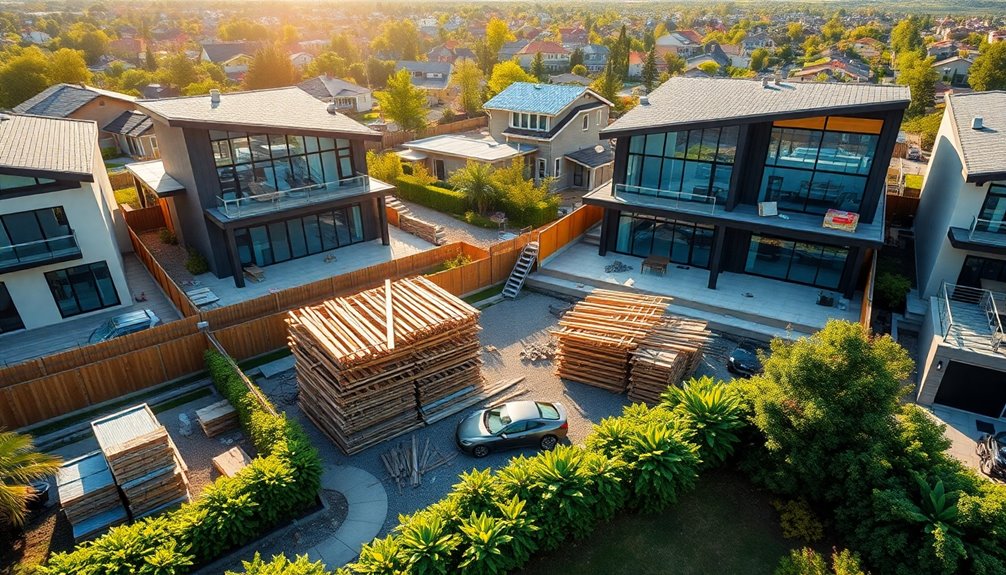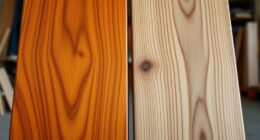Contemporary homes are expensive mainly due to their structural complexity and the high-quality materials used. You'll find that open floor plans require extra support, increasing both labor and material costs. Skilled labor is hard to find, which drives prices up even more. Additionally, the custom design process adds unique features that cater to your tastes but also inflate expenses. Finally, factors like location and market dynamics play a vital role in pricing. If you want to understand more about the specific elements that contribute to these costs, there's plenty more to explore.
Key Takeaways
- Structural complexity and the need for skilled labor increase costs, as contemporary homes require precise planning and additional support beams.
- High-quality and specialty materials drive up expenses, with premium options like copper roofing and recycled materials enhancing aesthetics and durability.
- The custom design process involves extensive collaboration and adjustments, adding to both time and costs for homeowners seeking tailored solutions.
- Open floor plans are in high demand, often commanding higher prices due to their appeal and potential resale value increase.
- Regulatory compliance and supply chain issues contribute to delays and increased costs, as meeting building codes and material shortages complicate construction.
Structural Complexity

When you consider contemporary homes, their structural complexity often stands out as a defining feature.
You'll notice fewer walls and more open spaces, which means additional structural beams are necessary to support upper floors. This sleek design often uses special steel beam construction to prevent racking, requiring meticulous planning and precision.
Every surface serves a purpose, increasing the complexity and the overall construction costs. Additionally, the framing needs precision, where each lumber board must be shaved flat, leaving no room for imperfections.
The absence of trim means exposed floors must be flawless, adding to labor time and material costs. Moreover, increased demand for modern designs contributes to the overall costs associated with these intricate homes.
Ultimately, the engineering required for these intricate designs greatly impacts both the complexity and the expense of building contemporary homes.
High-Quality Materials
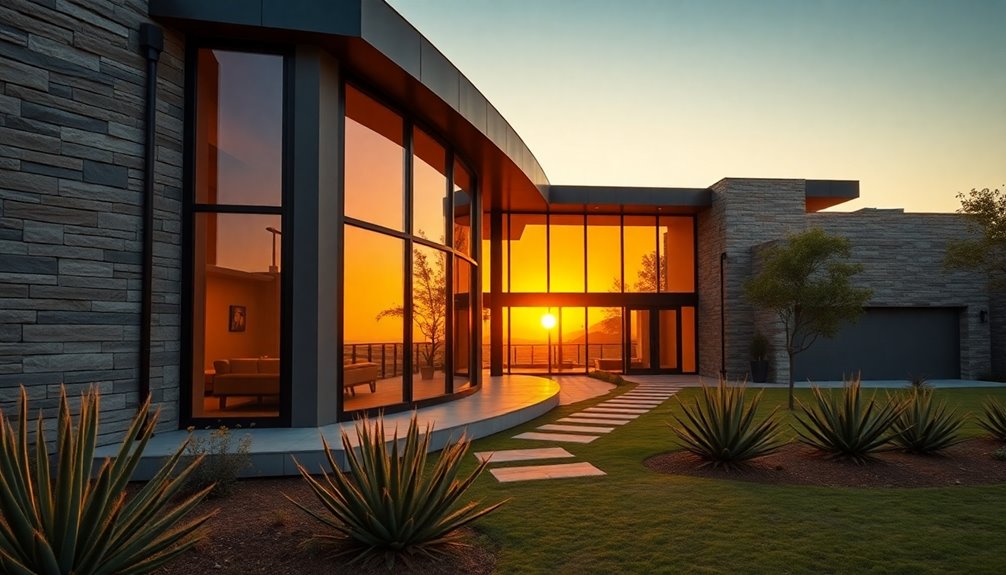
When building your contemporary home, selecting high-quality materials is essential for both aesthetics and durability. You'll need to take into account specialty roofing requirements and high-end finishing touches that elevate your design. Investing in these premium materials not only enhances the home's appearance but also adds significant value. For instance, using durable and low maintenance materials like brick can ensure that your home stands the test of time while maintaining its classic look.
Premium Material Selection
Choosing premium materials is essential for achieving the desired aesthetic and functionality in contemporary homes. By selecting natural and recycled options like bamboo flooring and reclaimed wood, you contribute to sustainability while enhancing visual appeal. Materials such as glass, concrete, and steel offer that sleek, modern look many homeowners crave. Using aluminum not only guarantees durability but also promotes eco-friendliness in your design. Incorporating local materials can further enhance both sustainability and the connection to the environment.
High-end finishes, like polished concrete and recycled glass countertops, elevate your home's overall quality but come with a price. Additionally, the growing demand and supply chain issues have driven up costs for these advanced materials. Sustainable and eco-friendly features ultimately make investing in premium materials help assure your home stands out, both in design and longevity.
Specialty Roofing Requirements
Investing in premium materials doesn't stop at interior finishes; it extends to the roofing that crowns your home. Specialty roofing options like copper, slate, and shake offer unique aesthetics, unmatched durability, and environmental benefits. Here's a quick comparison of these materials:
| Roofing Type | Lifespan | Environmental Benefit |
|---|---|---|
| Copper | 50+ years | Sustainable, weather-resistant |
| Slate | 100+ years | Natural, low maintenance |
| Metal | Up to 80 years | Energy-efficient, durable |
| Shake | 30+ years | Natural charm, eco-friendly |
| Premium Underlayment | Varies | Protects vulnerable areas |
Choosing high-quality roofing materials not only enhances your home's aesthetic appeal but also guarantees long-lasting performance. Moreover, investing in professional roofing services ensures quality installation and compliance with safety standards, further protecting your investment. Additionally, selecting materials with energy-efficient properties can contribute to lower utility costs, making your home more sustainable.
High-End Finishing Touches
High-end finishing touches can transform your contemporary home into a sanctuary of luxury and sophistication. Using unique materials like cork, live-edged woods, and nano glass elevates your interiors, while sleek matte metals impart a modern vibe. Custom window solutions, crafted with precision, not only enhance aesthetics but also guarantee energy efficiency, albeit at a higher cost. Additionally, the use of high-quality hardwood flooring provides a timeless appeal that complements various design styles. Advanced flooring options, especially engineered hardwood, offer durability and elegance, allowing for a variety of styles. Don't overlook high-quality interior elements like marble countertops and designer lighting fixtures, which add a refined touch. Investing in these luxurious materials and finishes makes your home stand out, but it also greatly increases overall costs, reflecting the true value of contemporary design. Furthermore, incorporating eco-friendly practices in your home's construction can lead to long-term savings and a reduced environmental impact.
Labor-Intensive Construction
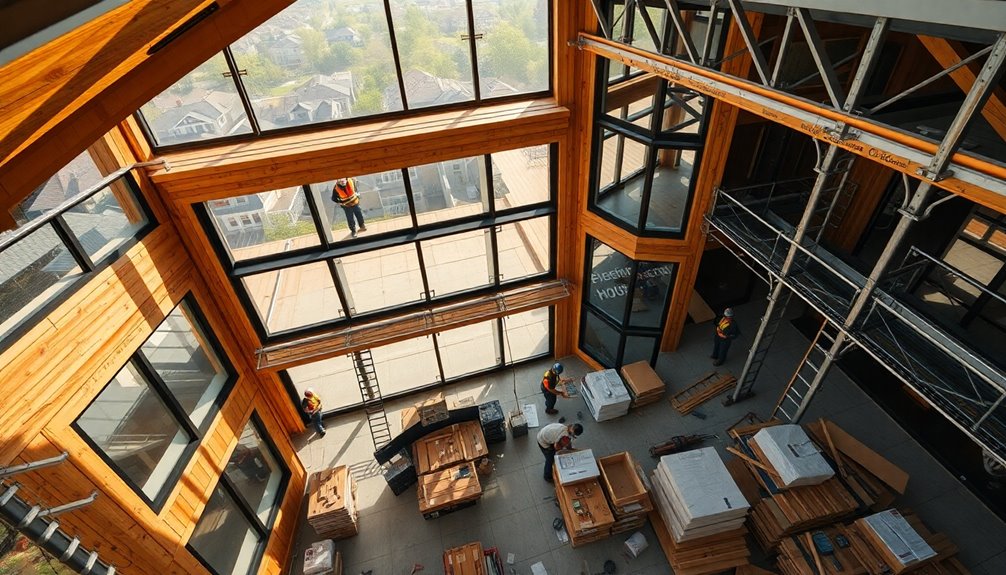
As you explore the world of contemporary homes, you'll quickly realize that labor-intensive construction is a defining characteristic. These homes require meticulous precision, which means every detail counts.
Special steel beams support expansive spaces and glass walls, increasing labor costs. With fewer walls, the structure becomes more complex, demanding skilled labor. Each board must be shaved flat to meet the exacting standards of modern architecture, leaving no room for flaws.
Specialty contractors are essential for tasks like laser-setting metal edging, which most drywall hangers can't handle. Labor shortages in the construction industry further strain resources, leading to project delays and potential quality control issues. As a result, 91% of construction firms report difficulty filling craft and salaried positions, impacting the availability of skilled labor.
This high level of craftsmanship inevitably drives up costs for contemporary homes.
Open Floor Plans
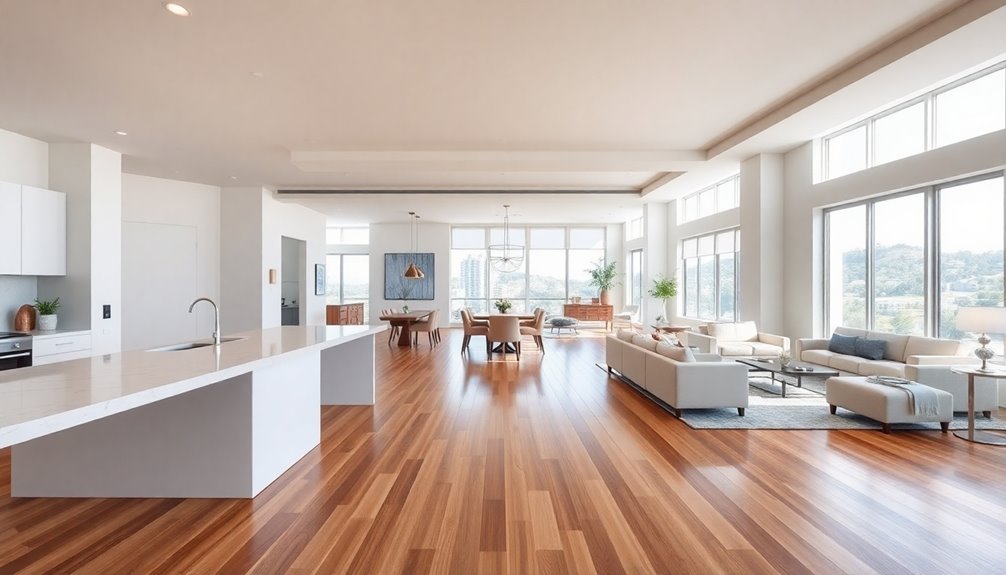
Contemporary homes aren't just defined by their labor-intensive construction but also by their innovative layouts, such as open floor plans.
These designs can greatly boost resale value, increasing property worth by up to 7. 4%. You’ll find that open concepts offer flexible configurations, making entertaining easier and allowing natural light to flow freely throughout your space. Incorporating elements like large windows and multifunctional furniture can further enhance the overall ambiance. Additionally, integrating spa design principles for relaxation can transform your home into a tranquil retreat, promoting a sense of well-being. These thoughtful touches not only improve daily living but also make your property more appealing to future buyers.
While you might face some storage challenges, creative use of nooks can enhance your living area. Open floor plans foster social interaction, letting you connect with family and friends effortlessly. Additionally, homes with open layouts often sell faster in competitive markets, reflecting changing lifestyles and family dynamics.
Plus, they accommodate various activities, from homework to casual dining, all while maintaining an organized, unified look that showcases your personal style.
Custom Design Process
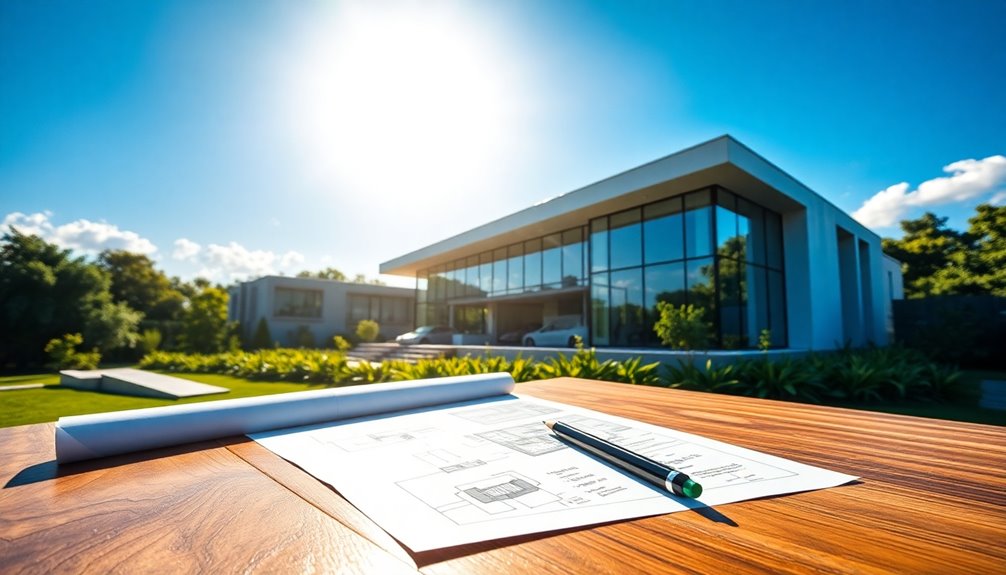
When beginning the custom design process for your contemporary home, it's essential to start with a clear vision.
You'll kick things off with an initial input session, where you gather ideas, sketches, and inspirations. Share everything from napkin doodles to magazine clippings. This collaboration helps create a program that outlines your wishes and establishes a mutual design direction.
Next, you'll receive initial sketches or renderings, typically within two weeks. After reviewing them, you'll make minor adjustments before finalizing the design.
The process continues with programming, where you define your home's functional needs. As you refine the design and finalize working drawings, you'll also receive cost estimates to guarantee everything fits within your budget. This structured approach keeps your vision on track, while detailed feedback is crucial to guide adjustments and ensure alignment with your expectations.
All-Inclusive Services
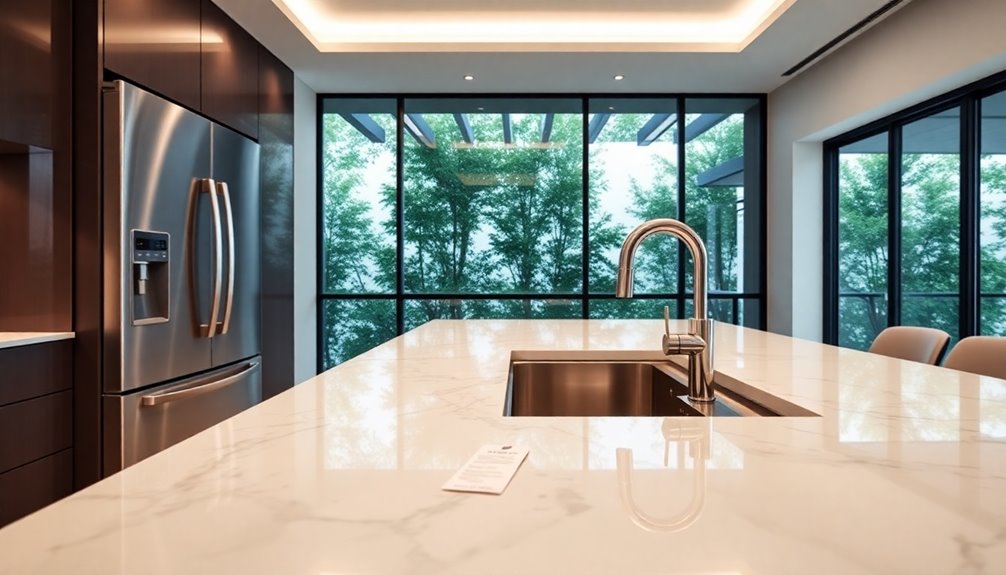
Whether you're dreaming of a serene retreat or a vibrant family hub, all-inclusive services enhance your contemporary home experience by providing a range of amenities designed for comfort and convenience.
Imagine lounging by an infinity pool or enjoying private beach access. You'll love the ease of watersports, fully-equipped kitchens, and even private chefs whipping up delicious meals. Incorporating relaxation techniques into your routine can further enhance your enjoyment of these luxurious amenities.
With complimentary Wi-Fi and regular housekeeping, life becomes effortless. Plus, flexible floor plans guarantee everyone—from kids to seniors—feels at home. These designs not only foster comfort but also consider accessibility for all ages.
You'll appreciate the safety features like non-slip floors and level entrances. Custom packages, detailed plans, and a residential warranty assure quality and peace of mind.
With all these perks, your contemporary home isn't just a living space; it's a lifestyle.
Frequently Asked Questions
How Does Location Affect the Cost of Contemporary Homes?
Location greatly impacts the cost of contemporary homes. When you choose a property near tech hubs or reputable schools, you're likely to face higher prices due to increased demand.
Being close to amenities like shopping, healthcare, and public transport adds value, too. Neighborhoods with unique charm and a strong community spirit can inflate home prices, making them more desirable.
Ultimately, the combination of these factors drives up costs for homes in prime locations.
What Role Do Building Permits Play in Overall Expenses?
Building permits play a significant role in your overall expenses when constructing a home.
They can range from $525 to over $3,000, depending on your project's complexity. These fees cover necessary administrative and engineering costs, and if you're tackling a large project, you might face even higher permit costs.
Regulatory restrictions can further inflate land prices, contributing to the overall expense of your contemporary home. Understanding these costs is essential for your budget planning.
Are There Financing Options Available for Custom Home Builds?
When you're considering financing options for custom home builds, you've got several paths to explore.
On one hand, construction loans offer specialized funding but require substantial down payments.
On the other, construction-to-permanent loans simplify the process by merging phases, though they can be more costly.
Traditional mortgages remain a safer choice for existing homes.
Local banks might provide personalized service, giving you flexibility tailored to your project's unique needs.
Choose wisely!
How Do Energy-Efficient Features Influence Home Costs?
Energy-efficient features can greatly influence your home costs.
While upfront investments in smart thermostats, energy-efficient windows, and solar panels may seem high, they often lead to substantial savings on utility bills over time.
You'll notice reduced heating, cooling, and energy expenses, making your home more economical in the long run.
Plus, these features can enhance your home's value, making it a smart choice for both your budget and the environment.
What Maintenance Costs Should Be Expected for Contemporary Homes?
When you own a contemporary home, you should budget for annual maintenance costs ranging from $1,400 to $2,300.
Use the 1% rule to set aside 1% of your home's purchase price each year. Additionally, consider specific tasks like HVAC servicing, roof repairs, and landscaping.
Remember that your region and the home's age will impact these costs, so regular inspections and prompt repairs can help you avoid more significant expenses down the line.
Conclusion
In today's market, the high costs of contemporary homes often raise eyebrows, but understanding the reasons behind these prices can ease your concerns. Yes, it might seem overwhelming, but investing in structural complexity, quality materials, and skilled labor means you're getting a durable, personalized space that fits modern lifestyles. While the initial price tag may be hefty, the long-term value and satisfaction of your dream home can make it all worth it.
